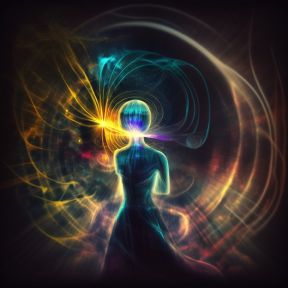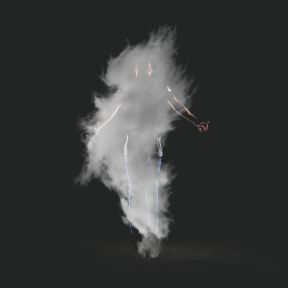
Near-Death Experiences
A near-death experience (NDE) is the conscious, semi-conscious or recollected experience of someone who is approaching or has temporarily begun the process of dying—for example, during a cardiac arrest that is followed by resuscitation. People who recall near-death experiences have described perceiving a variety of surreal phenomena, such as seeing themselves from above or passing through a tunnel of light.
Reports of these experiences sometimes include religious or spiritual interpretations and have fueled debates about whether a person’s consciousness can persist after death. Some scientists dispute that NDEs reflect post-mortem consciousness and have sought to explain them in terms of changes in brain function during the process of dying.

Thanks to advanced medical care, it has become increasingly common for people on the verge of dying to be revived and returned to normal consciousness, even after their body has begun to shut down. A subset of these people recall episodes from the period of time before they awoke that are often extraordinary and personally meaningful. The descriptions may include some details that are particular to the individual (such as seeing a family member) and others that appear, in some version, in many people’s NDE reports.
A near-death experience is, simply, an experience that a person reports having had while in a physical state in which the risk of death was imminent. Commonly, the person’s heart temporarily ceased to function at some point prior to recovery, as after a heart attack. Reports of NDEs can include images, sensations, and other conscious elements that are often vivid and striking.
The nature of near-death experiences varies from case to case, but some features have appeared in multiple reports. Feelings of peacefulness or serenity are typical in NDE accounts. They may also include vivid imagery, such as bright light, movement through a tunnel, or visions of events from one’s past (also called a “life review”). Some NDEs include “out-of-body experiences,” in which one feels removed from one’s physical body. And some reports describe encounters with other beings, such as loved ones or anonymous entities perceived as angels.
For some, the different elements of a near-death experience may unfold in sequence—for example, passage into darkness, followed by a sense of leaving one’s body and seeing it from outside, and then an apparent encounter with a mysterious being, ultimately ending with a return to regular consciousness.
In one reported near-death experience, a man whose heart had stopped beating and who showed no signs of brain activity was subsequently revived. Later, he recalled having encountered a “compassionate being” during the episode who gave him a feeling of warmth. In another case, a woman described a memory of floating above her body, looking down at the doctors who were treating her and listening to what they said.
Estimates vary, with some suggesting that as many as 10 to 20 percent of people who have been declared dead have had a near-death experience. In one study of patients who had survived cardiac arrest, 9 percent of survivors who could be interviewed reported a NDE.
Some other experiences seem to overlap partly with NDEs. Out-of-body experiences, one potential element of a NDE, can also occur in circumstances in which death is not imminent—such as while a person is under anesthesia. Comparisons have been made between NDEs and experiences people have while on certain kinds of hallucinogenic drugs. Events that may prompt NDE-like phenomena also include fever, fainting, injury, and other physiological disruptions.
While a sense of joy or serenity is a commonly mentioned feature of near-death experiences, there have also been reports of frightening near-death experiences. These may involve negative feelings provoked by a typical NDE phenomenon (such as feeling outside of one’s body), a sense of being alone in darkness, or other frightening scenes. This kind of NDE appears to be relatively rare.

Given the remarkable stories of those who have near-death experiences—and a general curiosity about the nature of death and what does (or doesn’t) follow it—NDEs have invited a variety of interpretations. Some find spiritual validation in the mysterious accounts of what may seem like a brush with the afterlife. Skeptics of that view point instead to potential brain-based reasons for such vivid experiences.
And, of course, individuals who have survived a near-death state grapple with the meaning of their own experiences, and some report positive changes in their outlook on life and death. No matter the ultimate explanation for NDEs, experts encourage those close to these individuals to allow them to talk about these potentially impactful experiences and to respond non-judgmentally.
People who have near-death experiences may find religious significance in what they remember: They might conclude, for example, that an out-of-body experience and the sense of movement toward light represented their soul departing for heaven, or that they interacted with an angel or God. The details of these interpretations seem to vary based on a person’s religious background. More broadly, people who have a NDE may feel that they have encountered something divine, a glimpse of the afterlife, or some other truth beyond the realm of the normal.
While many people interpret vivid near-death experiences as evidence that a person’s consciousness or soul continues to exist after death, from a scientific perspective, NDEs do not prove that life continues after death. While NDEs are not fully understood, various potential explanations that do not involve a disembodied consciousness have been explored.
Multiple hypotheses have been proposed, with some bearing on particular elements of near-death experiences. For example, out-of-body experiences in NDEs may be accounted for by the disruption of the temporal parietal region, key to the sense of embodiment, as the brain approaches death. And some have suggested that the tunnel imagery of many NDEs is due to the effect of slowed-down blood flow on the retinas. However, the neurological basis of NDEs is not yet fully understood, and some researchers are open to alternative accounts that go beyond brain activity.
One hypothesized explanation for near-death experiences is that the body releases the hallucination-inducing chemical such as dimethyltryptamine (DMT) when it is near death, but this has yet to be established. There are similarities between experiences caused by hallucinogens and near-death experiences; however, there is evidence that ketamine has effects that are more similar to NDEs than are the effects of DMT.
Near-death experiences can leave a lasting impression on the person who has survived. Among the transformative effects described by those who had NDEs are an increased sense of purpose and appreciation and a reduced fear of death. A person may report becoming more open and loving in the aftermath of a NDE. And in some cases, the person may perceive that they have gained intuitive abilities, such as seeming to know what someone is thinking or feeling.














